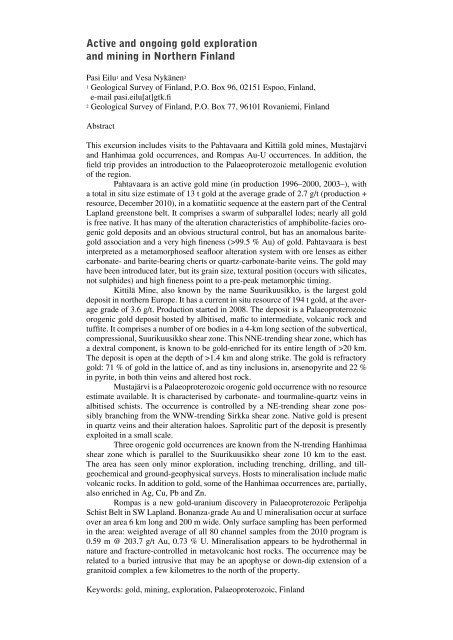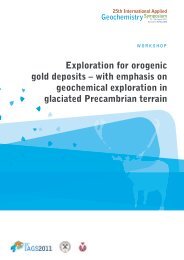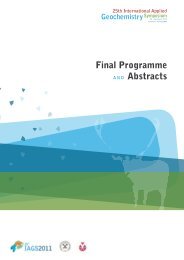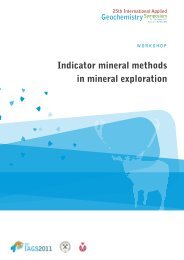Active and ongoing gold exploration and mining in ... - IAGS 2011
Active and ongoing gold exploration and mining in ... - IAGS 2011
Active and ongoing gold exploration and mining in ... - IAGS 2011
You also want an ePaper? Increase the reach of your titles
YUMPU automatically turns print PDFs into web optimized ePapers that Google loves.
<strong>Active</strong> <strong>and</strong> <strong>ongo<strong>in</strong>g</strong> <strong>gold</strong> <strong>exploration</strong><br />
<strong>and</strong> <strong>m<strong>in</strong><strong>in</strong>g</strong> <strong>in</strong> Northern F<strong>in</strong>l<strong>and</strong><br />
Pasi Eilu1 <strong>and</strong> Vesa Nykänen2 1 Geological Survey of F<strong>in</strong>l<strong>and</strong>, P.O. Box 96, 02151 Espoo, F<strong>in</strong>l<strong>and</strong>,<br />
e-mail pasi.eilu[at]gtk.fi<br />
2 Geological Survey of F<strong>in</strong>l<strong>and</strong>, P.O. Box 77, 96101 Rovaniemi, F<strong>in</strong>l<strong>and</strong><br />
Abstract<br />
This excursion <strong>in</strong>cludes visits to the Pahtavaara <strong>and</strong> Kittilä <strong>gold</strong> m<strong>in</strong>es, Mustajärvi<br />
<strong>and</strong> Hanhimaa <strong>gold</strong> occurrences, <strong>and</strong> Rompas Au-U occurrences. In addition, the<br />
field trip provides an <strong>in</strong>troduction to the Palaeoproterozoic metallogenic evolution<br />
of the region.<br />
Pahtavaara is an active <strong>gold</strong> m<strong>in</strong>e (<strong>in</strong> production 1996–2000, 2003–), with<br />
a total <strong>in</strong> situ size estimate of 13 t <strong>gold</strong> at the average grade of 2.7 g/t (production +<br />
resource, December 2010), <strong>in</strong> a komatiitic sequence at the eastern part of the Central<br />
Lapl<strong>and</strong> greenstone belt. It comprises a swarm of subparallel lodes; nearly all <strong>gold</strong><br />
is free native. It has many of the alteration characteristics of amphibolite-facies orogenic<br />
<strong>gold</strong> deposits <strong>and</strong> an obvious structural control, but has an anomalous barite<strong>gold</strong><br />
association <strong>and</strong> a very high f<strong>in</strong>eness (>99.5 % Au) of <strong>gold</strong>. Pahtavaara is best<br />
<strong>in</strong>terpreted as a metamorphosed seafloor alteration system with ore lenses as either<br />
carbonate- <strong>and</strong> barite-bear<strong>in</strong>g cherts or quartz-carbonate-barite ve<strong>in</strong>s. The <strong>gold</strong> may<br />
have been <strong>in</strong>troduced later, but its gra<strong>in</strong> size, textural position (occurs with silicates,<br />
not sulphides) <strong>and</strong> high f<strong>in</strong>eness po<strong>in</strong>t to a pre-peak metamorphic tim<strong>in</strong>g.<br />
Kittilä M<strong>in</strong>e, also known by the name Suurikuusikko, is the largest <strong>gold</strong><br />
deposit <strong>in</strong> northern Europe. It has a current <strong>in</strong> situ resource of 194 t <strong>gold</strong>, at the average<br />
grade of 3.6 g/t. Production started <strong>in</strong> 2008. The deposit is a Palaeoproterozoic<br />
orogenic <strong>gold</strong> deposit hosted by albitised, mafic to <strong>in</strong>termediate, volcanic rock <strong>and</strong><br />
tuffite. It comprises a number of ore bodies <strong>in</strong> a 4-km long section of the subvertical,<br />
compressional, Suurikuusikko shear zone. This NNE-trend<strong>in</strong>g shear zone, which has<br />
a dextral component, is known to be <strong>gold</strong>-enriched for its entire length of >20 km.<br />
The deposit is open at the depth of >1.4 km <strong>and</strong> along strike. The <strong>gold</strong> is refractory<br />
<strong>gold</strong>: 71 % of <strong>gold</strong> <strong>in</strong> the lattice of, <strong>and</strong> as t<strong>in</strong>y <strong>in</strong>clusions <strong>in</strong>, arsenopyrite <strong>and</strong> 22 %<br />
<strong>in</strong> pyrite, <strong>in</strong> both th<strong>in</strong> ve<strong>in</strong>s <strong>and</strong> altered host rock.<br />
Mustajärvi is a Palaeoproterozoic orogenic <strong>gold</strong> occurrence with no resource<br />
estimate available. It is characterised by carbonate- <strong>and</strong> tourmal<strong>in</strong>e-quartz ve<strong>in</strong>s <strong>in</strong><br />
albitised schists. The occurrence is controlled by a NE-trend<strong>in</strong>g shear zone possibly<br />
branch<strong>in</strong>g from the WNW-trend<strong>in</strong>g Sirkka shear zone. Native <strong>gold</strong> is present<br />
<strong>in</strong> quartz ve<strong>in</strong>s <strong>and</strong> their alteration haloes. Saprolitic part of the deposit is presently<br />
exploited <strong>in</strong> a small scale.<br />
Three orogenic <strong>gold</strong> occurrences are known from the N-trend<strong>in</strong>g Hanhimaa<br />
shear zone which is parallel to the Suurikuusikko shear zone 10 km to the east.<br />
The area has seen only m<strong>in</strong>or <strong>exploration</strong>, <strong>in</strong>clud<strong>in</strong>g trench<strong>in</strong>g, drill<strong>in</strong>g, <strong>and</strong> tillgeochemical<br />
<strong>and</strong> ground-geophysical surveys. Hosts to m<strong>in</strong>eralisation <strong>in</strong>clude mafic<br />
volcanic rocks. In addition to <strong>gold</strong>, some of the Hanhimaa occurrences are, partially,<br />
also enriched <strong>in</strong> Ag, Cu, Pb <strong>and</strong> Zn.<br />
Rompas is a new <strong>gold</strong>-uranium discovery <strong>in</strong> Palaeoproterozoic Peräpohja<br />
Schist Belt <strong>in</strong> SW Lapl<strong>and</strong>. Bonanza-grade Au <strong>and</strong> U m<strong>in</strong>eralisation occur at surface<br />
over an area 6 km long <strong>and</strong> 200 m wide. Only surface sampl<strong>in</strong>g has been performed<br />
<strong>in</strong> the area: weighted average of all 80 channel samples from the 2010 program is<br />
0.59 m @ 203.7 g/t Au, 0.73 % U. M<strong>in</strong>eralisation appears to be hydrothermal <strong>in</strong><br />
nature <strong>and</strong> fracture-controlled <strong>in</strong> metavolcanic host rocks. The occurrence may be<br />
related to a buried <strong>in</strong>trusive that may be an apophyse or down-dip extension of a<br />
granitoid complex a few kilometres to the north of the property.<br />
Keywords: <strong>gold</strong>, <strong>m<strong>in</strong><strong>in</strong>g</strong>, <strong>exploration</strong>, Palaeoproterozoic, F<strong>in</strong>l<strong>and</strong>






